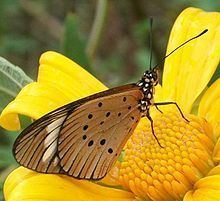Scientific name Telchinia encedon | Genus Acraea Rank Species | |
 | ||
Similar Acraea, Acraea neobule, Acraea serena, Acraea egina, Acraea zetes | ||
Acraea encedon, the common acraea, white-barred acraea or encedon acraea, is a butterfly of the Nymphalidae family. It is found in tropical Africa and south-western Arabia. It is one of the species of Acraea sometimes separated in Telchinia.
Contents
Description
The wingspan is 40–50 millimetres (1.6–2.0 in), with the female being slightly larger than the male, but otherwise similar in pattern and colour. The apex of the forewing is blackish and divided by a white bar. The rest of the surface of the wings are usually orange with black spots, however paler varieties with a greyish or yellowish base colour are also found.
The butterfly is a polymorphic Müllerian mimic of Danaus chrysippus, which is a highly unusual phenomenon as Müllerian mimicry is almost always monomorphic.
Distribution
There are two subspecies:
Life cycle
The eggs are oval in shape. The larvae feed on Commelina species, such as C. diffusa. The flight period of the adults is all year, but they are most common from March to May. They are slow fliers, and perch on low-growing vegetation.
In some populations there are two kinds of females, one producing offspring in a normal 1:1 sex ratio, the other producing females only. In other populations the sex ratio is apparently normal. Scientists first believed the distorted sex-ratio was caused by a driving W chromosome. Later research suggests it is caused by cytoplasmic bacteria.
